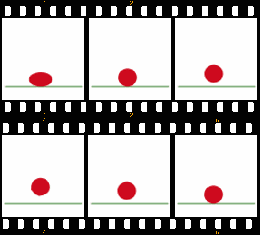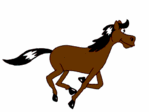Animation
2007 Schools Wikipedia Selection. Related subjects: Computer & Video games; Films

The bouncing ball animation (below) consists of these 6 frames.
This animation moves at 10 frames per second.
Animation is the filming a sequence of drawings or positions of models to create an illusion of movement. It is an optical illusion of motion due to the phenomenon of persistence of vision.
Early animation
There is no such being as the creator of animation, as there were several people doing several projects which could be considered various types of animation all around the same time. The following is a brief on those who are often acknowledged as significant to the development of animation. Note that this list is by no means a comprehensive list of contributors to early animation.
Georges Méliès was a creator of special effect films, such as A Trip to the Moon. He used many techniques – one of which was to stop the camera rolling, change something in the scene, and then continue rolling the film. This is a very similar idea to that of stop motion animation. Meleises accidentally happened upon the technique when his camera broke down while shooting a bus driving by. When the camera was fixed, a horse happened to be passing by just as Méliès continued to film. The result was that the bus appeared to change into a horse.
Émile Cohl began drawing cartoon strips and created a film in 1908 called Fantasmagorie. The film was largely comprised of a stick figure moving about and encountering all manner of morphing objects, such as a wine bottle that transforms into a flower. There were also sections of live action where the animator’s hands would enter the scene. The film was created by drawing each frame on paper and then shooting each frame onto negative film, which gave the picture a blackboard look.
Winsor McCay created detailed animations that required a team of artists and painstaking attention for detail. Each frame was drawn on paper, requiring backgrounds to be redrawn, as well characters to be animated. His films such as Gertie the Dinosaur (1914) and The Sinking of the Lusitania (1918) were of an impressive scale, althought The Sinking of the Lusitania used cels.
In 1919 Otto Messmer created the character of Felix the cat for Pat Sullivan's animation studios. The importance of Felix lies in the character's strong personality, created largely through gesture and actions.
Animation techniques
Animation techniques are incredibly varied and difficult to categorize. Techniques are often related or combined. The following is a brief on common types of animation. Again, this list is by no means comprehensive.
Traditional animation
Also called cel animation, the frames of a traditionally animated movie are hand-drawn. The drawings are traced or copied onto transparent plastic sheets called cels, which are then placed over a painted background and photographed one by one on a rostrum camera. Nowadays, the use of cels (and cameras) is mostly obsolete, since the drawings are scanned into computers, and digitally transferred directly to 35 mm film. The "look" of traditional cel animation is still preserved, and the character animator's work has remained essentially the same over the past 70 years. Because of the digital influence over modern cel animation, it is also known as tradigital animation.
Examples: The Lion King, Spirited Away, Les Triplettes de Belleville
- Full animation
- The most common style in animation, known for its realistic and often very detailed art.
- Examples: All Disney feature length animated films, The Secret of NIMH, The Iron Giant
- The most common style in animation, known for its realistic and often very detailed art.
- Limited animation
- A cheaper process of making animated cartoons that does not follow a "realistic" approach.
- Examples: The Flintstones, Yellow Submarine
- A cheaper process of making animated cartoons that does not follow a "realistic" approach.
- Rubber hose
- The characters are usually cartoony, and the animators have a lot of artistic freedom as rubber hose animation dont have to follow the laws of physics and anatomy in the same degree as the other main styles in animation.
- Examples: Early Mickey Mouse cartoons, Ren and Stimpy, Popeye
- The characters are usually cartoony, and the animators have a lot of artistic freedom as rubber hose animation dont have to follow the laws of physics and anatomy in the same degree as the other main styles in animation.
- Rotoscoping
- A technique where animators trace live action movement, frame by frame, for use in animated films.
- Examples: Gulliver's Travels, A Scanner Darkly, American Pop
- A technique where animators trace live action movement, frame by frame, for use in animated films.
Stop motion
This is any type of animation which requires the animator to alter the scene, shoot frame, alter the scene and shoot a frame and so on, to create the animation.
- Cutout animation
- This is a type of stop motion animation. Here the figures are comprised of several 2-dimensional pieces which are moved individually, frame by frame, to create movement.
- Examples: the animated sequences of Monty Python's Flying Circus, Tale of Tales
- This is a type of stop motion animation. Here the figures are comprised of several 2-dimensional pieces which are moved individually, frame by frame, to create movement.
-
- Silhouette animation
- A type of cutout animation where the viewer only sees black silhouettes. The world's oldest surviving animated feature film ( The Adventures of Prince Achmed, 1926) used this method.
- Silhouette animation
- Graphic animation
- Puppet animation
- Again a type of stop motion animation. Here figures are puppets, generally with an armature inside of them to keep them still and steady as well as allow them to move at particular joints. The puppets are moved frame by frame, much like in cutout animation.
- Examples: The Nightmare Before Christmas, Robot Chicken, The Tale of the Fox
- Again a type of stop motion animation. Here figures are puppets, generally with an armature inside of them to keep them still and steady as well as allow them to move at particular joints. The puppets are moved frame by frame, much like in cutout animation.
-
- Brickfilm
-
- Model animation
-
-
- Go motion
-
- Clay animation
- Often abbreviated to claymation, this is also a type of stop-motion animation. The difference of course being that the figures are made of clay or a similar malleable material. The figures often have an armature inside of them, effectively making it a type of puppet animation. However, this is not always the case, notably in the films of Bruce Bickford where clay creatures continuosly morph into a variety of different shapes.
- Examples: Creature Comforts, Dimensions of Dialogue by Jan Švankmajer, The Amazing Mr. Bickford
- Object animation
- Pixilation
- Puppetoon
Computer animation
Like stop motion, this encompasses a variety of techniques, the unifying idea being that the animation is created digitally on a computer.
- 3D animation
- Figures are created in the computer using polygons. To allow these meshes to move they are given a digital armature. This process is called rigging. Various other techniques can be applied, such a simulated fur or hair, effects such as fire and water and the use of motion capture to name but a few.
- Examples: The Incredibles, Shrek
-
- Cel-shaded animation
-
- Morph target animation
-
- Motion capture
- Analog computer animation
- Flash animation
Less common techniques
Drawn on film animation
A technique where footage is produced by creating the images directly on film stock.
Paint-on-glass animation
A technique for making animated films by manipulating slow-drying oil paints on sheets of glass.
Pinscreen animation
Makes use of a screen filled with movable pins, which can be moved in or out by pressing an object onto the screen. The screen is lit from the side so that the pins cast shadows. The technique has been used to create animated films with a range of textural effects difficult to achieve with traditional cel animation.
Sand animation
Sand is moved around on a backlighted piece of glass to create each frame for an animated film.
Combining techniques
As mentioned, techniques are often combined for either creative or economic reasons. The Mysterious Geographic Explorations of Jasper Morello is a cutout animated film, but is created on a computer. South Park has gone from being composed of paper cutouts, to being created of cutouts created in the computer. The Iron Giant, meanwhile, was completely cel animated with the exception of its title character, who was created in 3D and cel shaded.
Other techniques and approaches
- Character animation
- Chuckimation
- Multi-sketching
- Onion skinning
- PowerPoint animation
- Skeletal animation
- Special effects animation
- Windows Movie Maker Animation


